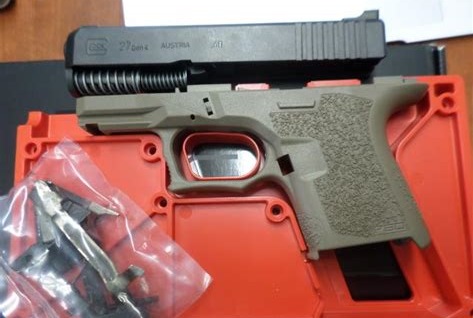
They Also Falsely Claim That The Kits Only Require “Assembly”
From the Editorial:
“Ghost guns are firearms purchasers assemble themselves without serial
numbers, making them easy to obtain and hard to trace. Some are
“printed” on 3-D printers and include no metal, allowing owners to carry them through metal detectors undetected.”
So, what is the reality? ATF considers any gun without a serial number to be a “ghost gun” The vast majority of these firearms are commercially produced guns with obliterated serial numbers. Some of these firearms are home built – either from scratch or from a partially completed kit. All of these firearms must include significant amounts of metal. They are ALL detectable by metal detectors. Attempts to build guns without metal have all failed.
All firearms have one central part that is legally the firearm. This part is highly controlled and tracked. The rest of the gun is just parts.
Of course, this central part (usually the “receiver”) starts out as just a hunk of metal or plastic. At some point during the production process, these raw materials must legally become a firearm – requiring a serial number, tracking, etc. ATF has, for decades, set this point at 80% completion.
If these kits actually required only assembly, the included receiver would have to be 100% complete – which would mean that the kit would include a firearm, which would require a background check, and a traceable trail to the first retail buyer, just like all other firearms. The truth is that the receiver in these kits is less than 80% complete, requiring a significant amount of work to complete before assembly. So, again, the Sun Times statement is false.
Nothing illustrates this better than the FGC-9. This firearm uses largely, but not entirely, 3D printed parts. The metal parts can be made from materials commonly available in hardware stores. No gun parts are required. It is so dependable that it is being used by Myanmar Guerilla fighters.
Could US lawmakers ban all 3D printed and/or homemade guns? Maybe, but there are constitutional questions. Would such a ban be effective? Absolutely not.
While we would like to stop all criminals from obtaining firearms, the reality is that they will always find a way. They do not need to use “ghost gun kits”. If they were made unavailable, they would simply use other methods – as in fact, they are doing right now. So called “ghost guns” built from kits, comprise just a tiny faction of crime guns. According to a DOJ study of 240k prison inmates who had firearms at the time of their arrest, 84% obtained the firearm from an illegal dealer, via direct theft, via an illegal “straw purchase” or by other illegal means such as borrowing or renting the gun from another criminal. Will some criminal build guns from kits? Sure they will – but close that door and they will simply walk through another.
The reality of gun control laws is quite simple: They only affect the law abiding citizen. Criminals who want firearms always will find a way to get them.
So, what is the reality? ATF considers any gun without a serial number to be a “ghost gun” The vast majority of these firearms are commercially produced guns with obliterated serial numbers. Some of these firearms are home built – either from scratch or from a partially completed kit. All of these firearms must include significant amounts of metal. They are ALL detectable by metal detectors. Attempts to build guns without metal have all failed.
In Addition, The Article’s Claim That Firearms Kits Only Require “Assembly” Is Completely False.
All firearms have one central part that is legally the firearm. This part is highly controlled and tracked. The rest of the gun is just parts.
Of course, this central part (usually the “receiver”) starts out as just a hunk of metal or plastic. At some point during the production process, these raw materials must legally become a firearm – requiring a serial number, tracking, etc. ATF has, for decades, set this point at 80% completion.
If these kits actually required only assembly, the included receiver would have to be 100% complete – which would mean that the kit would include a firearm, which would require a background check, and a traceable trail to the first retail buyer, just like all other firearms. The truth is that the receiver in these kits is less than 80% complete, requiring a significant amount of work to complete before assembly. So, again, the Sun Times statement is false.
Banning 3D Printed Firearms Is A Practical Impossibility
Nothing illustrates this better than the FGC-9. This firearm uses largely, but not entirely, 3D printed parts. The metal parts can be made from materials commonly available in hardware stores. No gun parts are required. It is so dependable that it is being used by Myanmar Guerilla fighters.
Could US lawmakers ban all 3D printed and/or homemade guns? Maybe, but there are constitutional questions. Would such a ban be effective? Absolutely not.
The reality of criminals and firearms
While we would like to stop all criminals from obtaining firearms, the reality is that they will always find a way. They do not need to use “ghost gun kits”. If they were made unavailable, they would simply use other methods – as in fact, they are doing right now. So called “ghost guns” built from kits, comprise just a tiny faction of crime guns. According to a DOJ study of 240k prison inmates who had firearms at the time of their arrest, 84% obtained the firearm from an illegal dealer, via direct theft, via an illegal “straw purchase” or by other illegal means such as borrowing or renting the gun from another criminal. Will some criminal build guns from kits? Sure they will – but close that door and they will simply walk through another.
The reality of gun control laws is quite simple: They only affect the law abiding citizen. Criminals who want firearms always will find a way to get them.












